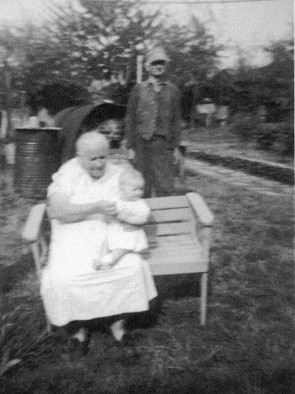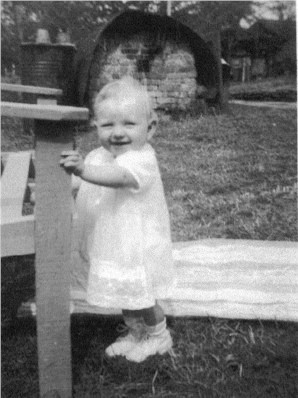|
| |
The Outdoor Ovens

BACK
|
Delicious
aromas wafted from backyard ovens
By Glenn Tunney, For the Herald-Standard
10/08/2005
We often tend to think of
"memories" as being visual, such as mental images of faces and places from
the past, or aural, allowing us to "hear" once-familiar voices or sounds
from long ago. But some of our most delightful memories are of wonderful
tastes and smells from our childhood. Those memories can make us suddenly
hungry when we remember a particular delicious food or tantalizing aroma.
For some folks raised in
this region, the source of that heavenly aroma was found not in the
kitchen, but rather in the backyard. The mouth-watering fragrance was
coming from the family's outdoor brick oven. Like the coal-fired stove
that we discussed in last week's column, the outdoor oven played a vital
role in feeding the family of yesteryear.
"I
am 70 years old," says Jerry LaMonica, now of Dearborn Heights, Mich.,
"and I was the youngest of 12 children in my family. We needed a lot of
bread to keep us going, and the small oven in our family's gas stove was
insufficient for baking our bread."
(continued)
|
 Anna
Briscar holds granddaughter Ann Marie Gallagher as our Great Grandfather
George Felegi looks on from behind. Anna
Briscar holds granddaughter Ann Marie Gallagher as our Great Grandfather
George Felegi looks on from behind.
Note the oven in the background with the brick and steel construction.
When it was time for baking, Baba Anna
would invite the neighbor ladies and baking would be done for all their
families. The smell of bread would travel throughout Lemont.
|

This photo shows Ann Marie Gallagher as a toddler with the oven in the
background. |
|
(continued)
Jerry was raised in Newboro, between
Buffington and Fairbank. As a child he reveled in the tasty delights that
his mother baked in the family's backyard oven. Jerry still recalls how
each member of the family had a certain responsibility on baking day.
Baking for a family of 14 could be a daunting challenge.
"We had a brick oven at the rear of our yard," Jerry remembers, "and about
once a week, we baked bread. I say 'we' because it was a family affair.
Either Mama or one of my older sisters would start the process by pouring
flour from a 100-pound sack into a wooden tub that was about the size of a
galvanized washtub. Then water, yeast and salt were added, and the mixing
and punching would begin.
"While this was being done, a fire was started in the oven. Newspaper,
kindling and larger wood was placed inside and lit. The fire would burn
for hours, heating the floor and bricks of the oven while the bread dough
was rising and being punched back and rising again. When the dough was
just right, it was formed into loaves and placed into bread pans about 18
inches long and maybe nine or 10 inches wide. It was then allowed to rise
again.
"When it was time for the bread to be placed into the oven, Mama would
pull the red-hot ashes from the oven and check the temperature by tossing
a handful of flour onto the floor of the oven. The speed at which the
flour turned brown let her know when the temperature was right. If it was
too hot, she swabbed the floor with a wet towel attached to the end of a
long stick. When it was just right, Mama called for the bread and we kids
came running, each carrying a pan of bread dough.
"The tantalizing aroma of baking bread soon began drifting throughout the
neighborhood. We would bake two batches of bread like that. Then Mama
would make pizza, which we were eating long before most people ever heard
of it. On those occasions when Mama did not make pizza, Papa would take a
loaf fresh out of the oven and with a sharp knife, slice it in half
lengthwise. He would sprinkle olive oil over the steaming halves and add a
bit of salt and pepper. Then we all gathered around him and began breaking
off chunks of hot bread. It was delicious!
"After the 16 or so loaves of bread cooled, they were placed into a wooden
box which was about four feet long, 10 inches high, and 30 inches deep.
The loaves were covered with a blanket, and the wooden lid was set on
top."
What better way to enjoy the walk to school on a crisp morning than to
smell baking bread as you strolled through the patch with your friends? It
was almost enough to make a fellow alter his usual route to school.
"The company houses in Smock had outdoor coal-heated bake ovens," recalls
Bob Simpson of Vacaville, Calif. "There was one for each duplex home, and
it was shared by the two families. I still remember walking to school and
smelling the wonderful aroma of baking bread.
"The two families would coordinate their baking needs and bake on the same
day, eliminating the necessity of firing up the oven too often. The firing
of the ovens was 'men's work,' while the baking was 'women's work' and was
done once or twice each week. I remember seeing my grandmother rolling
dough on the kitchen table. She would cover the table with a clean piece
of oil cloth that was only used for kneading bread, and she would be up to
her elbows in dough. The yeasty smell of the rising bread was great."
Hank Greenberg, who grew up in Brownsville and now lives in Woodland
Hills, Calif., still has pleasant memories of a simple childhood pleasure
that he associates with "baking day."
"My family had a regular stove," Hank recalls, "but lucky for us, our
next-door neighbor had a round, outdoor wood-fired brick oven with a metal
door. She used to put large round pieces of dough in and close the door,
and soon a fantastic odor would waft through the neighborhood."
It was as if a tune was being played by the Pied Piper and had reached the
ears of the neighborhood children. All were mystically drawn by the
irresistible fragrance, quickly converging upon its source.
"We children would gather in front of the oven and sit down to wait until
the bread was baked," Hank remembered. "Then this generous lady would take
the hot bread out of the stove, cut large slices, slather it with
delicious butter, and give each child a slice. What a treat!"
It would be hard to match freshness like that today. The homemade bread
was a perfect complement to the home-cooked meals that Mom or Grandma
produced daily in the kitchen of yesteryear.
"In the days of my youth," Bob Simpson recalled, "our meals were all
prepared 'from scratch,' as very few semi-prepared foods were available.
The preparation of large meals such as Sunday dinner resembled a ballet in
the kitchen, with everything carefully timed so that all of the food was
ready at the right time."
If coordinating preparation of the meal was not enough of a challenge,
during World War II there was an additional hurdle to be cleared by
creative cooks. The government rationed many vital ingredients of a good
meal.
"We had food rationing," Bob explained, "but because we lived in a rural
community in which many of the farmers slaughtered their animals, meat was
never a problem. However, sugar was always in short supply, so some people
used a substitute sweetener, a nasty product known as saccharine. Coffee
was also in short supply, and some people replaced or extended their
coffee with chicory. Since gasoline was rationed, it was necessary to plan
meals ahead and make an accurate shopping list for our weekly trip to the
A&P store in Brownsville."
"The big meal of the week was Sunday dinner after arriving home from
church, and it was usually served around three o'clock to allow Mom time
to prepare it. On Sunday, supper was a meal that Mom did not have to
prepare, and it was the informal meal of the week. Quite often my dad
would cook something, and he was also a great cook. Since that was Mom's
time off, Dad and I would clean the kitchen and wash all the dishes."
One of the items to be washed was often a black cast iron skillet, common
years ago but less frequently found in the modern kitchen. There are some
cooks today who still have a treasured old cast iron skillet that they use
when preparing certain dishes.
"My dad used to 'cure' cast iron skillets by building an outside wood
fire," explained Bob Simpson, "and he would heavily coat the skillet with
fat. He would plunge it into the hot, burning wood coals, allow the fat to
burn, and then let the pan cool. He would repeat this process several
times until the skillet had a black, shiny appearance. These skillets were
only lightly washed and carefully dried after use, and food didn't seem to
stick."
Of course, times have changed. Because of the time-consuming nature of
baking and cooking three meals a day in the primitive kitchen of
yesteryear, the task of meal preparation did not usually fall solely upon
Mom's shoulders. The children were often involved in the baking or
cooking, and even Dad might be called upon to fire the outdoor oven or
cook a casual supper.
Another modern change from the mealtimes of yesteryear was the makeup of
the group who consumed those meals - Mom, Dad, and all of the kids, seated
at the table as a family, enjoying together the bounty of the backyard
garden or the chicken coop, and appreciating Mom's long labors in the
kitchen or at the outdoor oven.
It was truly another era. Some families still eat meals together as a
family.
For many though, the modern merger of mobility, the microwave, and
McDonald's has made a family meal something experienced only by looking at
a Norman Rockwell magazine cover.
Could it be that the time-consuming backyard brick oven, the cantankerous
coal-fired stove, and the tedious preparation "from scratch" of a family's
daily meals, had more positive benefits than anyone realized? For all that
the modern kitchen has gained in efficiency and convenience, has something
more important been lost?
Is there a way to somehow combine the speed and convenience of the modern
kitchen with the family cohesiveness that was nurtured in the simple
kitchen of yesteryear?
Perhaps that is a feat which would require no magical formula - only a
determined family effort.
Glenn Tunney may be contacted at 724-785-3201 or 6068 National Pike East,
Grindstone, PA 15442. Comments about these weekly articles may be sent to
Editor Mark O'Keefe, 8-18 E. Church St., Uniontown, PA or e-mailed to
mo'keefe@heraldstandard.com
. All past articles are on the Web at
http://freepages.history.rootsweb.com/~glenntunneycolumn/
ŠThe
Herald Standard 2005
|
BACK
|
![]()
 Anna
Briscar holds granddaughter Ann Marie Gallagher as our Great Grandfather
George Felegi looks on from behind.
Anna
Briscar holds granddaughter Ann Marie Gallagher as our Great Grandfather
George Felegi looks on from behind.